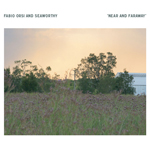|
|
 |
Dusted Reviews
Artist: Fabio Orsi & Seaworthy Album: Near and Faraway Label: Low Point Review date: Aug. 21, 2009 |

|
|
|
 |
In drone and especially ambient music, the ability to eschew a mechanical or electronic sensation while producing heavily manipulated sound cannot be underestimated. It withdraws the point of origination from the sound, leaving only calmly wavering tones propagating through your environment. The reticent music begins to feel like nature, or at the least, an amplifier to the great aesthetic of nature (rural, urban or otherwise).
It’s hard to refer to anything post-minimalism, experimental ambient or the like as groundbreaking or even necessarily new 30 years in, but well-crafted albums in that vein continue to mesmerize the best of us. Italy’s Fabio Orsi and Australia’s Cameron Webb, both ever-keen to collaborate, have surpassed the “promising” era of their young careers. Their first release together, Near and Faraway – a definite mesmerizer – utilizes a Venn diagram approach. It allows the listener to not only analyze each musician’s plateau (one that reaches the upper echelons of the genre), but how the separate styles can congeal for an even more impressive sound.
Orsi’s solo piece, “Evening by Evening,” builds off a simple rhythmic ping. Thick, tempestuous chords of synthesized strings inflate and puncture throughout, while momentary hints of birdcalls or children’s voices repeatedly call into question exactly where these sounds emanate from. Orsi, as he’s done many times before, dissolves his presence from the song and leaves it to our surroundings.
Webb, as Seaworthy (which includes the additional talents of Sam Shinazzi and Greg Bird), creates a parallel vibe with “Branch and Stone.” With softer synthetic crescendos and subtler tones, Webb brings to life a more placid, though no less vivid sonic environment. Passing rumbles of low frequencies drift in the background, as glimpsing guitar melodies and delicate feedback saunter across the fore. One can’t help but picture a landscape eerily still and awkwardly settling just minutes after being ravaged by a severe storm.
When the two artists combine their talents for the title track (bookended by the individually-produced pieces), a middle ground is formed, evening the shortcomings of each contributor. Orsi’s dramatic crescendos are tempered and staggered by Webb’s more understated approach. This makes the central climax all the more gripping when it is finally unleashed. Suddenly Webb’s setting flips from directly after the storm to right before it. And it’s one you can’t help staring motionless at as it looms forward, the great wonder of nature ruthlessly tumbling in your direction.
By Michael Ardaiolo
|







